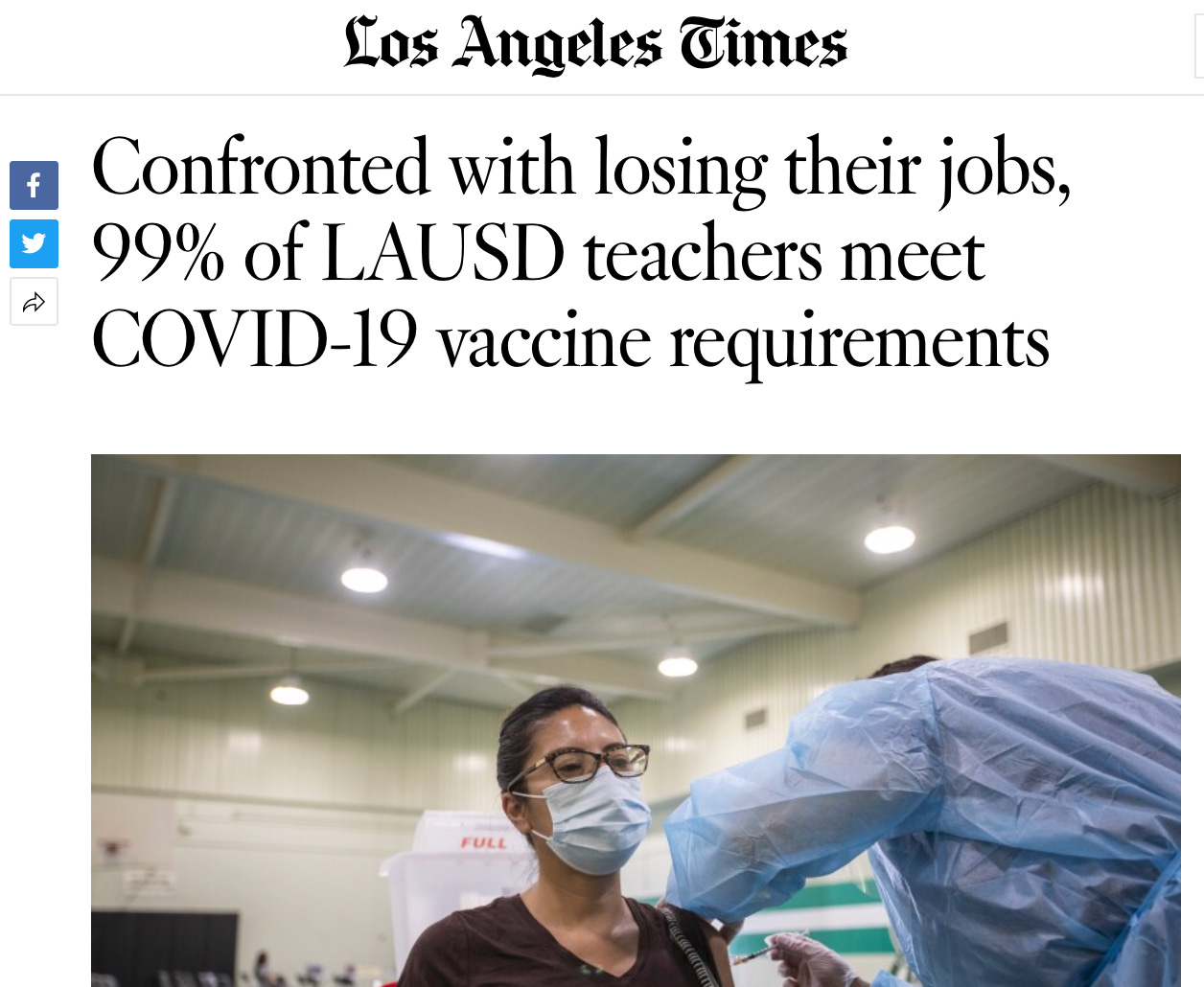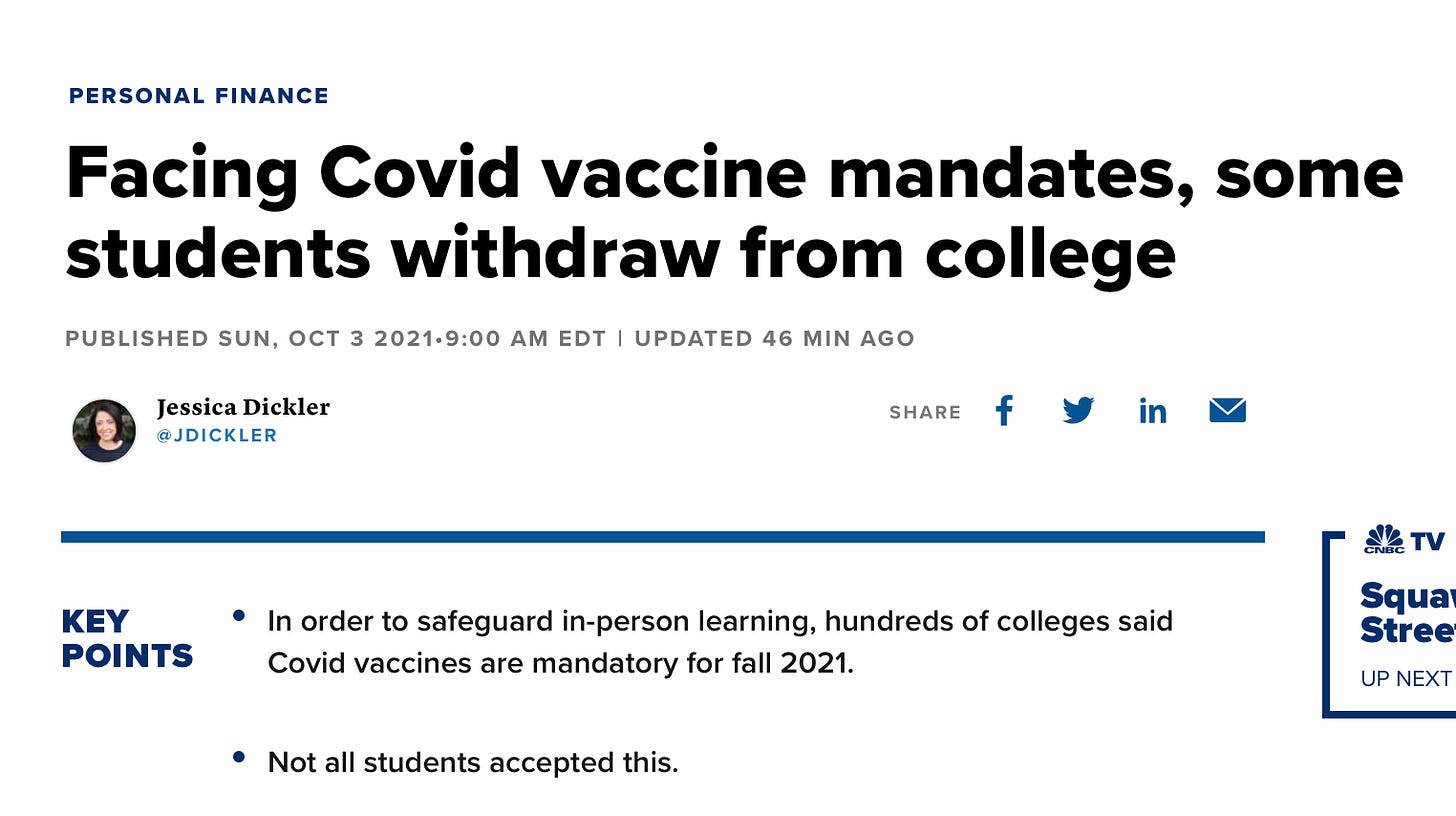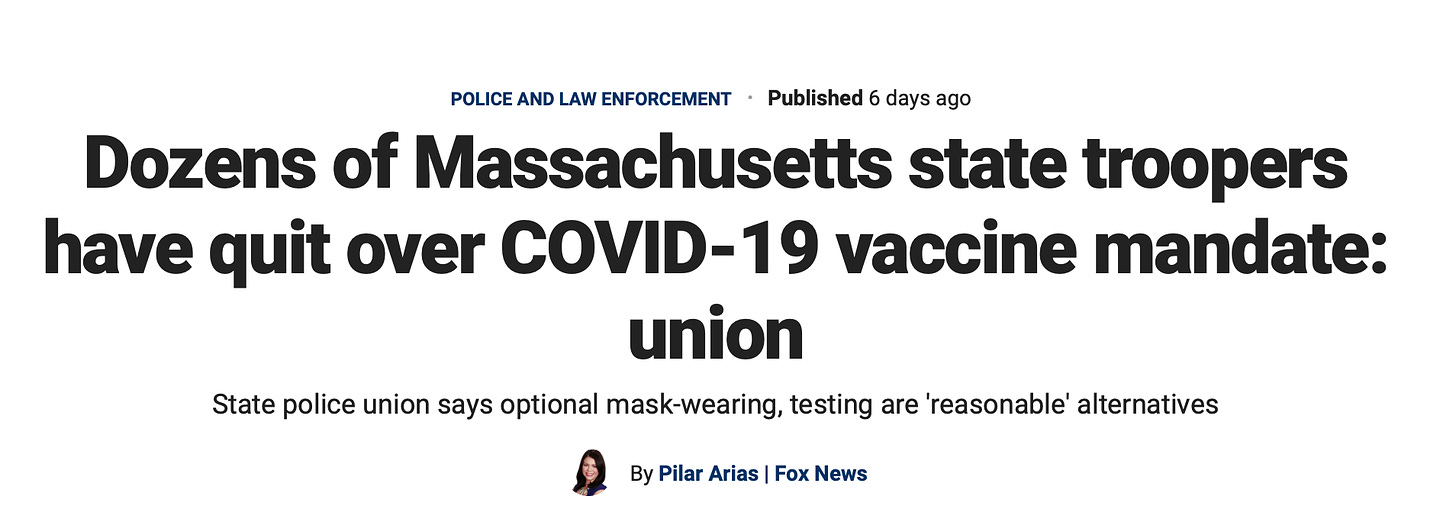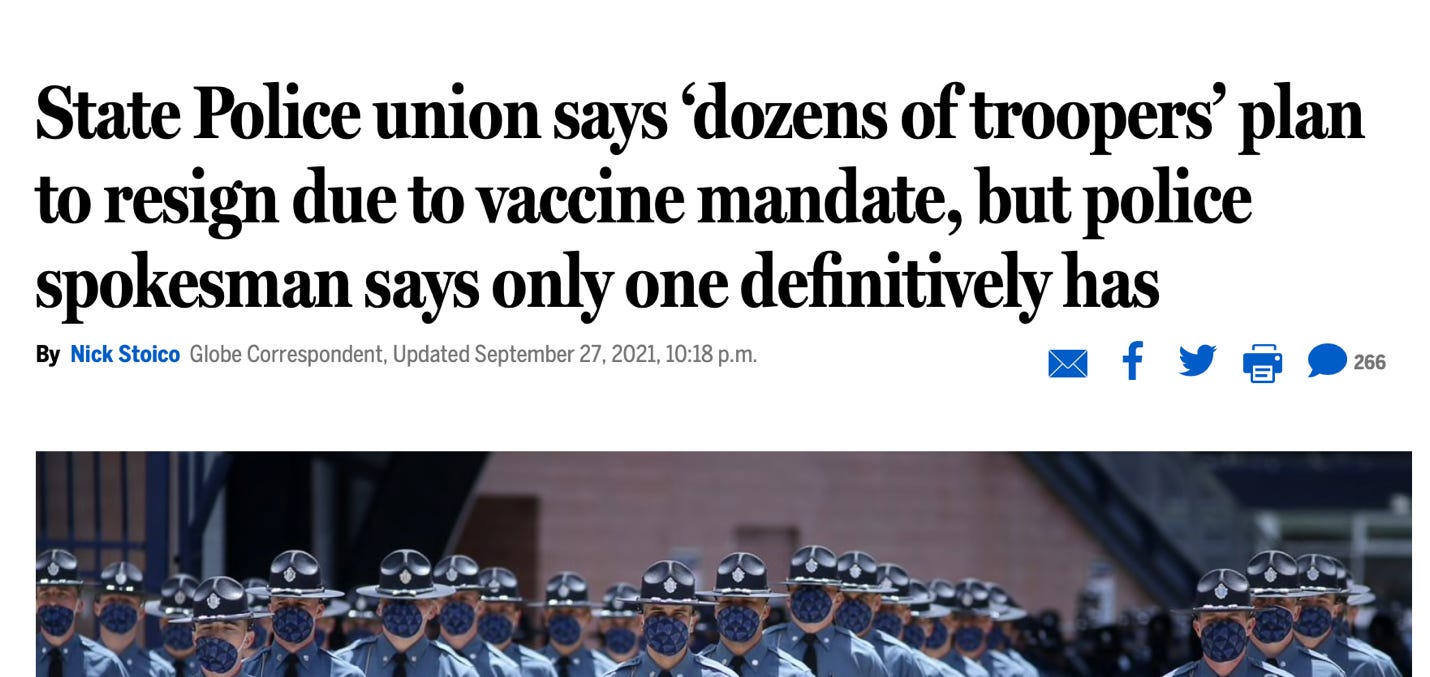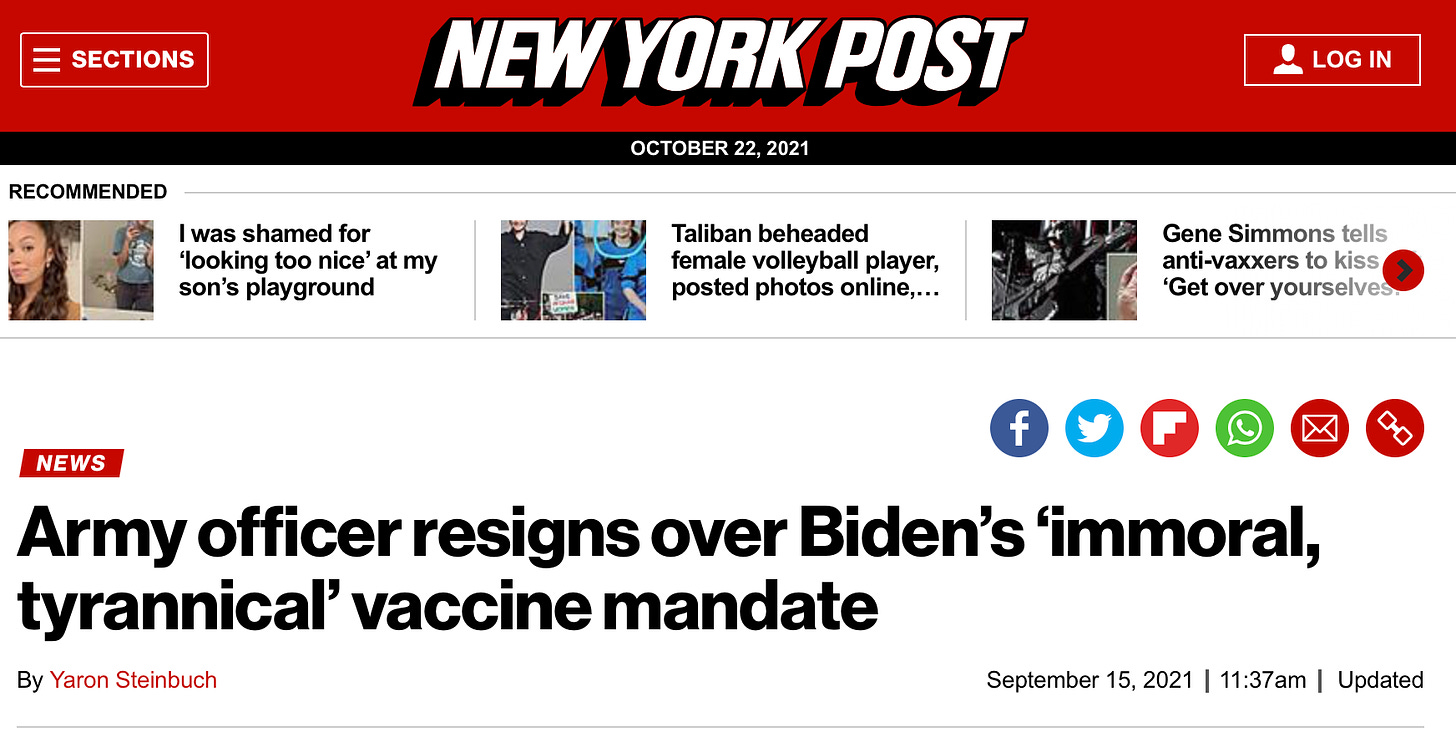What explains the bad vax mandate headlines?
Understanding the cognitive biases shaping coverage
You’ve seen the headlines.
And you’ve probably seen some of the pushback. Why frame the implementation of vaccine mandates by focusing on the objectors? What about the many more people who are complying with a public health measure that will make all of us safer?
Headlines are important. For many readers, it’s the only part of the story they look at, and provides the defining impression of the issue. Caveats and clarifications three paragraphs in leave much less of an impression.
An easy response to these headlines is to label them as clickbait. A more interesting question is to ask “why are they clickbait?” What are the cognitive biases that lead people to direct attention to headlines and stories that undermine our collective well-being? Here, I will talk about three: denominator neglect, a preference for anecdotes, and motivated reasoning.
Big takeaway: vaccine mandate coverage shaped by denominator neglect, a preference for anecdotes, and motivated reasoning makes for misleading headlines and erroneous beliefs
My views here are shaped by Behavioral Public Performance: How People Make Sense of Government Metrics, a short book about biases I recently co-authored with Asmus Olsen, Gregg Van Ryzin and Oliver James. These biases reveal how people are imperfect statisticians, even in high stakes situations like their personal health.
Denominator Neglect
When we are presented with ratios, we focus on the numerator. As the denominator gets larger, people fail to update their understanding of the ratio as a whole. Thus, if people are told there are 4,000 violent crimes per 1,000,000 people, this feels more dangerous than if they are told there are 4 violent crimes per 1,000, even though it’s the same ratio. This is called denominator neglect.
A classic example of denominator neglect is offered by Nobel Prize winner Daniel Kahneman. People are asked to choose an urn where, if they select a red marble, they will win a prize. In the first urn, there are 10 marbles, one of which is red. In the other, there are 100 marbles, eight of which are red. But 30-40% will choose the urn that gives them the 8% chance of winning rather than the 10% chance of winning. Why? Because eight is bigger than one. By focusing on the denominator, they have misunderstood the probabilities.
If the numerator feels like a lot, people might not look at the denominator at all. What they will remember is that a lot of people are losing their jobs because of vaccine mandates.
The above headlines above are all about the numerator. United is going to lay off 600 workers. That sounds like a lot! But to get some perspective, we need to know the denominator. In this case, the denominator is 67,000 employees. Therefore, more than 99% of employees were not fired. The Washington Post headline about a “mass termination” of 175 hospital employees? Deep into the article you learn that the denominator is 35,000 employees. Again, more than 99% of employees complied! Northwell Health has 650,000 employees. So more than 98% complied! In Washington State, 1,887 of employees who have left or been fired equates to about 3% of 63,000 employees.1
Look at the denominator, and it’s clear that vaccine mandates are working. Headlines that account for the denominator makes this success much more apparent.
Headlines that emphasize the frequency of the numerator but tell us little about the denominator exploit denominator neglect, leading to erroneous beliefs about the prevalence of a phenomena.
Anecdotes over data
There is another underlying bias here: we prefer stories of individuals to statistics about multitudes. Or as Stalin put it “a single death is a tragedy; a million deaths is a statistic.”2
My co-author Asmus Olsen has run a number of experiments which presents people with quantitative information about health services, and with stories of individuals. He shows that while people say they prefer statistical information to make judgements on health care, the experiments reveal that they are more apt to remember and be influenced by anecdotal information. The story of John’s botched heart operation sticks in our brain in a way that statistical tables of operation outcomes do not. Anecdotes provide an identifiable protagonist and evoke emotional responses. Numbers don’t. The story, rather than the statistic, stays with us.
This is not new information of course. It is why charities present pictures or narratives of individuals in fundraising. It is why much journalism is often centered around the experience of a single individual. Thus, the N of 1 becomes the ultimate numerator. Whether that individual is representative is another question.
Such stories can be made vivid by, among other things, presenting conflict. And so we focus on the disgruntled who fight the mandate, rather than those who welcome it. The rush to profile the disaffected can lead to coverage that doesn’t hold up. Lets take a couple of examples.
Students are dropping out of college because of vaccine mandates! Well, not so fast. The “some” in the headline is doing a lot of work. The reporter talked to two students.
One student dropped out of Montana State University even though Montana State University doesn’t have a vaccine mandate because he said he worried they might adopt a mandate. But they haven’t done so. Ok then.
The other student, Justin Mishler, left college during the pandemic to work, and has decided not to return to Northern Illinois University because he objects to a vaccine mandate. But his university mandate doesn’t require a vaccine. He could do a weekly test instead. Also, his place of employment, 3M falls under the federal vaccine mandate so its not clear why it represents a better option.
The reporter does note that Mishler is a member of college campus libertarian group. So we might reasonably infer that his views about vaccines are tied to his political beliefs. Left unsaid is that this appears the same Justin Mishler who is a boogaloo follower who previously complained about not being able to bring a gun onto the campus of Northern Illinois University. Knowing that the vaccine hesitant protagonist is also second civil war enthusiast seems like salient information to share when evaluating his public health judgement.
Let’s do another one.
Dozens of state troopers quit! Oh no! Hang on a second: it turns out that only one state trooper had definitively said he would retire.
There are, of course, examples of people who really did leave or were fired for not complying with vaccine mandates. Some of their stories went viral online and received widespread coverage, such as Washington State trooper Robert LaMay, and Lt. Col. Paul Douglas Hague.
In these headlines the act of quitting is itself a form of political expression, of defiance, in defense of liberty. By focusing on those exiting, the frame necessarily gives less attention to others. Co-workers who want to work in a safe and healthy environment. Or the driver pulled over and forced to interact with a state trooper who is unvaccinated.
Motivated Reasoning
The political nature of the story leads to the third bias: motivated reasoning, the idea that we select and interpret information consistent with our ideological beliefs. We seek out media coverage that matches our ideological worldview, and dismiss stories that do not.
For reasons that might have seemed hard to understand a few years ago, life-saving public health guidance has become viewed through people’s ideological lens. That perhaps makes is sound more principled than it is, since many ideological beliefs around COVID are embedded in conspiracy theories and misinformation. Have you seen any interviews where the protagonist says “I believe the vaccines are safe and effective; I just value by individual liberty over preventing the spread of the disease to others?”
For example, the state trooper who quit believes the false claim that vaccines may cause sterilization. Lt. Col. Hague labeled vaccines part of a “Marxist takeover of the military and United States government at their upper echelons” in his resignation letter. When queried how his resignation made sense given he had accepted previous mandated vaccines, his wife clarified “He didn’t resign over a vaccine. He said he felt the vaccine was being used as a political tool to divide and segregate Americans.” In other words, the opposition to the vaccine was a form of political expression as much as anything, a way of asserting membership in one group and opposition to another.
The net effect of motivated reasoning is that political conservatives will be most emotionally engaged with stories of people who share their political views losing their jobs. Their engagement with the story is less because they think that person has a well-founded understanding of how vaccines work, but rather because they believe members of their tribe are being unfairly persecuted. Hence, motivated reasoning explains why these sorts of headlines will be more present on conservative-leaning outlets, and more consumed by conservatives.
What About the Rest of Us?
As vaccine mandate deadlines pass, expect more stories that focus on those who object to mandates, giving them a broad platform for their views, a chance to present themselves as resisters fighting an oppressive system.
But what about the rest of us? The vast majority of people value their health, job and community over their political identity. Making those who don’t care about such things the central protagonist of a story is understandable given the biases described and the incentives of the media industry. But it is also an editorial choice to privilege a set of views that has led to tens of thousands of unnecessary deaths.
Coercive pressure has become necessary in the US because political persuasion has failed to get people to take a simple and safe action to curb a pandemic that has killed more than 700,000 and massively disrupted our lives. The US had a head start when it came to vaccines but fell behind.
We are are all held hostage by a political and media elite that has encouraged vaccine hesitancy, and now complains that the mandates needed to drag us to safety are a form of tyranny. That includes the mandate resisters being profiled in heroic terms by Fox News and other media companies that quickly enforced their own stringent vaccine mandates. Put another way, the person being profiled as a victim of mandates on Hannity or Tucker could not get a job working with Fox because Fox voluntarily adopted those same mandates.
Mandates will make some people unhappy, but they work. And perhaps those who are persuaded that vaccines are part of a Marxist plot might not have the right judgment for the military, Maybe those who insist that their liberty matters more than the safety of themselves and others are not best suited to serve and protect the public.
One reason we might expect exits to be higher in the public sector is that its workforce trends older with more generous retirement benefits, leaving more with the option to retire.




